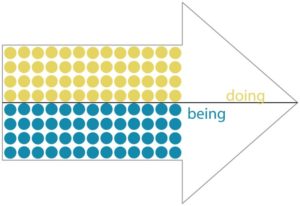Improve Dementia Patient Caregiver Mental Health and Reduce Stress with Mindfulness
By John M. de Castro, Ph.D.
“To my mother, I owe the experience of being with her since the beginning of her dementia, and the ability to notice what a difference mindfulness practice made in our relationship. From feeling only grief, to a growing acceptance of her in the moment, even appreciating new aspects of her personality that became freed as a result of her condition.” – Marguerite Manteau-Rao
Dementia is a progressive loss of mental function produced by degenerative diseases of the brain. Dementia patients require caregiving particularly in the later stages of the disease. Alzheimer’s disease is the most common type of dementia and accounts for 50 to 70 percent of dementia cases. Other types of dementia include vascular dementia, mixed dementia, dementia with Lewy bodies and frontotemporal dementia. For Alzheimer’s disease alone, there are an estimated 10 million caregivers providing 9 billion hours of care at a value of over $100 Billion dollars.
Caregiving for dementia patients is a daunting and all too frequent task. It is an intense experience that can go on for four to eight years with increasing responsibilities as the loved one deteriorates. In the last year, 59% of caregivers report that they are effectively on duty 24/7. Over time dementia will lead to loss of memory, loss of reasoning and judgment, personality and behavioral changes, physical decline, and death. The memory and personality changes in the patient may take away all those characteristics that make the loved one identifiable, unique, and endearing, producing psychological stress in the caregiver.
The feelings of hopelessness can be overwhelming regarding the future of a patient with an irreversible terminal degenerative illness. In addition, caregivers often experience an anticipatory grief associated with a feeling of impending loss of their loved one. If this isn’t bad enough, a little appreciated consequence is that few insurance programs cover dementia care outside of the hospital. So, medical expenses can produce extra financial strain on top of the loss of income for the caregiver. It is sad that 72% of caregivers report relief when their loved one passes away.
Obviously, there is a need to care for the caregivers of dementia patients. They play an essential and often irreplaceable role. So, finding ways to ease the burden is extremely important. Mindfulness practice for caregivers has been shown to help them cope with the physical and psychological demands of caregiving. In today’s Research News article “Mindfulness training for psychological stress in family caregivers of persons with dementia: a systematic review and meta-analysis of randomized controlled trials.” See summary below or view the full text of the study at: https://www.ncbi.nlm.nih.gov/pmc/articles/PMC5626236/, Liu and colleagues review and summarize the published Randomized Controlled Trials (RCTs) on the effectiveness of mindfulness training on the psychological state of caregivers for dementia patients.
They identified 7 published Randomized Controlled Trials (RCTs). The studies employed a variety of different mindfulness training techniques; including Mindfulness-Based Stress Reduction (MBSR), Acceptance and Commitment Therapy (ACT), and meditation practice. They report that the published studies find that mindfulness training produces a significant decrease in depression and perceived stress, a trend toward decreased anxiety, and significant improvement in mental health quality of life. The importance of these findings is underscored by the fact that these were all well controlled scientific studies of high quality. Hence, mindfulness training appears to be of significant help to caregivers of dementia patients improving their mental health and quality of life.
It has been demonstrated that mindfulness training improves anxiety, depression, and quality of life, and reduces stress in a wide variety of populations. So, it is not surprising that it has similar effectiveness for these caregivers. The magnitude of the burden on these caregivers, however, is such that the improvements produced by mindfulness training are a blessing. Hence, mindfulness training should be incorporated into routing support and treatment programs for caregivers of dementia patients.
So, improve dementia patient caregiver mental health and reduce stress with mindfulness.
“One of the major difficulties that individuals with dementia and their family members encounter is that there is a need for new ways of communicating due to the memory loss and other changes in thinking and abilities. The practice of mindfulness places both participants in the present and focuses on positive features of the interaction, allowing for a type of connection that may substitute for the more complex ways of communicating in the past.” – Sandra Weintraub
CMCS – Center for Mindfulness and Contemplative Studies
This and other Contemplative Studies posts are also available on Google+ https://plus.google.com/106784388191201299496/posts and on Twitter @MindfulResearch
Study Summary
Liu, Z., Chen, Q., & Sun, Y. (2017). Mindfulness training for psychological stress in family caregivers of persons with dementia: a systematic review and meta-analysis of randomized controlled trials. Clinical Interventions in Aging, 12, 1521–1529. http://doi.org/10.2147/CIA.S146213
Abstract
Caring for a relative with dementia is extremely challenging; conventional interventions may not be highly effective or easily available on some occasions. This study aimed to explore the efficacy of mindfulness training in improving stress-related outcomes in family caregivers of people with dementia using a meta-analytic review. We searched randomized controlled trials (RCT) through April 2017 from five electronic databases, and assessed the risk of bias using the Cochrane Collaboration tool. Seven RCTs were included in our review. Mindfulness interventions showed significant effects of improvement in depression (standardized mean difference: −0.58, [95% CI: −0.79 to −0.37]), perceived stress (−0.33, [−0.57 to −0.10]), and mental health-related quality of life (0.38 [0.14 to 0.63]) at 8 weeks post-treatment. Pooled evidence did not show a significant advantage of mindfulness training compared with control conditions in the alleviation of caregiver burden or anxiety. Future large-scale and rigorously designed trials are needed to confirm our findings. Clinicians may consider the mindfulness program as a promising alternative to conventional interventions.









